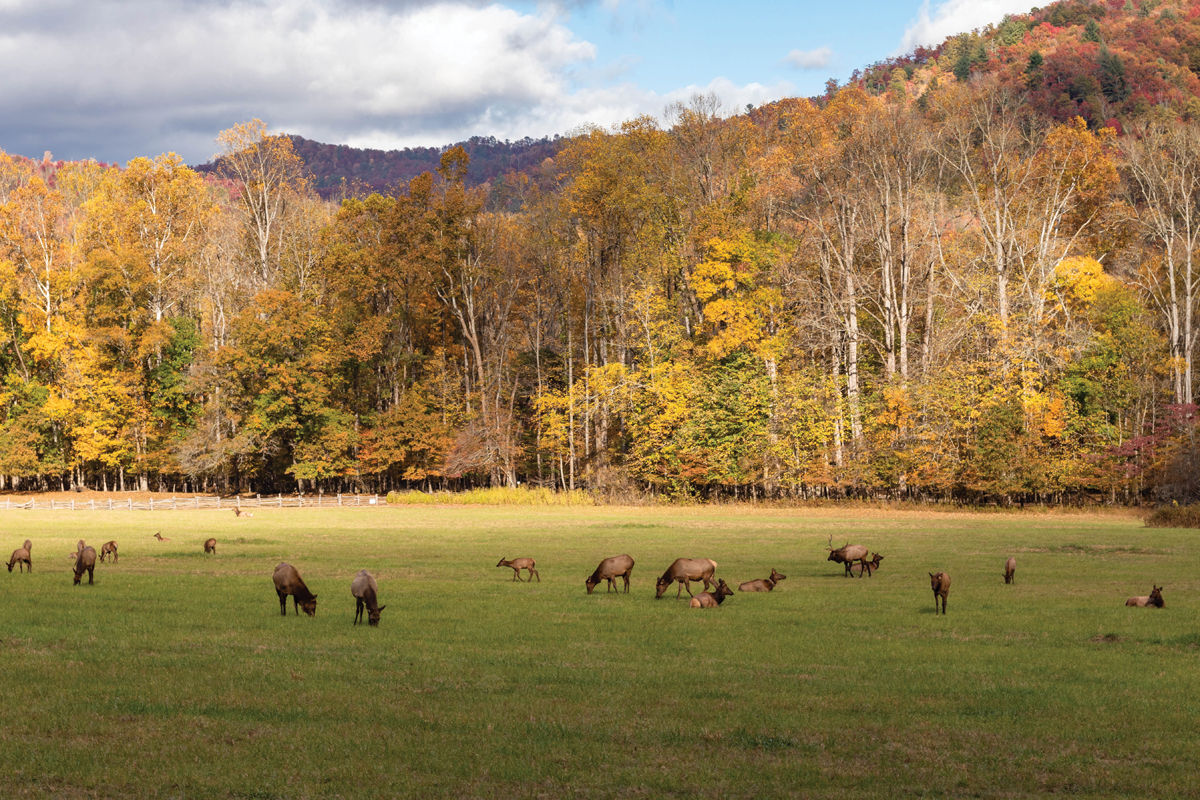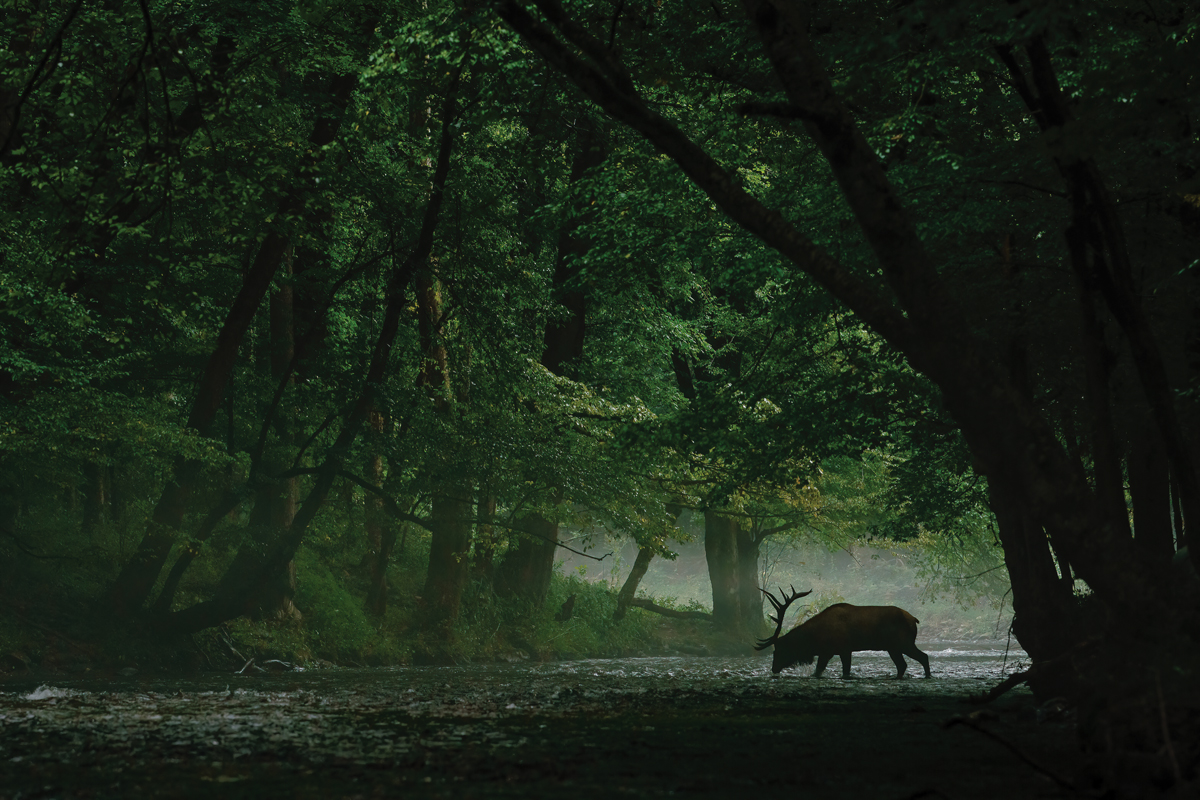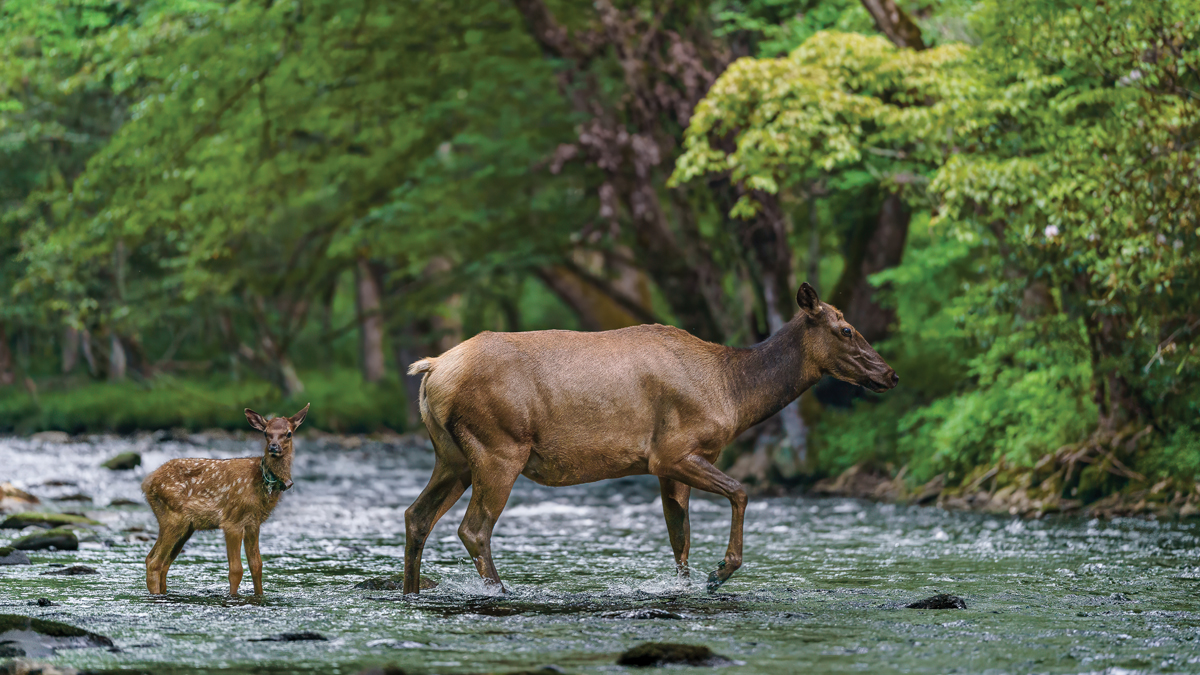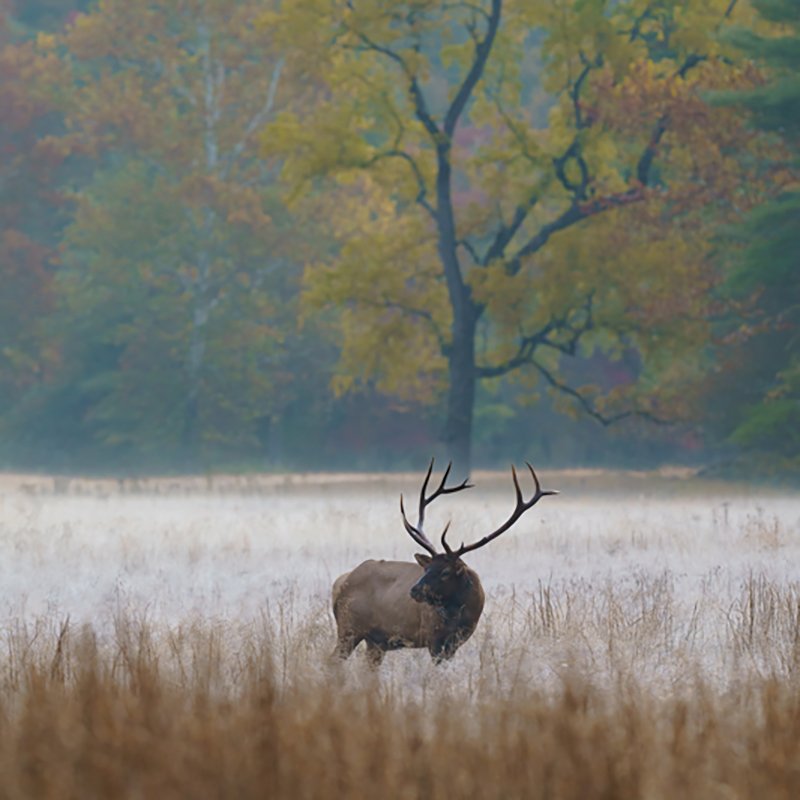Return of the Elk
Return of the Elk: Portraits of the Great Smoky Mountains’ elk, a species restored to our region by a park conservation project
The Great Smoky Mountains National Park, constructed in the ’30s and officially dedicated in 1940, has spent its lifetime protecting and preserving the flora and fauna of the Appalachian Mountain range. It was one of the first locales to be selected as a UNESCO World Heritage Site, and is also an International Biosphere Reserve. Both are honors given to landscapes that safeguard cultural and natural heritage.
In the eighty-odd years since the park has opened, it’s grown to protect more than just the landscape; black bears, for example, have thrived in the area and have even come to be a bit of a symbol for the park (see the Great Smokies license plates that sport them). But one of the most notable facets of the park is its gang of elk.
Reintroduced 13 years ago, elk were once extinct in our region, but thanks to conservation efforts from the National Park Service, the herd is thriving in its home in the Smokies. Although elk roam the park year-round, autumn is one of the best times to observe them since they are especially active during mating season.
Looking Back
In the 1700s and 1800s, European settlers began traversing through the Appalachian mountains, bringing harmful environmental actions with them. According to Joseph Yarkovich, a wildlife biologist with Great Smoky Mountains National Park, “before the arrival of Europeans, elk were native and abundant throughout all of North America, from Canada to Mexico, East Coast to West Coast. As the number of settlers increased, they brought with them some destructive practices from a wildlife standpoint. The biggest of those were overhunting, habitat loss, and competition with domestic livestock.”
Of those three main problems, the biggest was overhunting, Yarkovich explains. The meat market was in high demand, and like the bison population out West, elk were being hunted in droves at a much faster rate than they could reproduce. Before settlers arrived, elk were bounteous, with their highest population levels at over 10 million. Eventually, the Eastern elk, a subspecies native to the East Coast, was declared extinct in 1880. After the national population of Cervus canadensis dropped below 100,000 in the 1880s, conservationists out West began to set aside protected land for the remaining herds, and also began implementing laws that regulated elk hunting. Because of these past efforts to protect North American elk, the GSMNP was eventually able to start its own conservation program by relocating Manitoban elk to the national park.

Cataloochie Valley (above) is one of the most popular spots to see elk since they’re commonly found roaming here.
Conservation
Although the program’s got its first hooves on the ground in 2001, the quest to reintroduce the species actually began in the ’90s. “It was actually considered an experiment within the national park,” Yarkovich explains. “It wasn’t a full reintroduction. It was an experiment to see if elk could survive and make it on their own without humans.” Years before their arrival in WNC, the national park collected a variety of research—habitat analyses, disease risk, environmental assessments, and more—to determine if the experiment was viable. After evaluating all factors, the researchers decided to pull the trigger and bring elk from nearby regions to the park.
The first herd was a small one, counting in at just 25 elk, followed by 27 more a year later. “The experiment ended up taking eight years, but at the end of that eight years, all population growth models showed that the herd was stable. They were growing—they were going to be able to make it here on their own. So that led the park to consider it a reintroduction rather than an experiment,” Yarkovich explains. The latest research shows that there are over 260 elk now thriving in the Great Smokies.
Since their reintroduction, biologists have continued to study the herd, monitoring its health and environmental impact. The researchers tracked the elk by radio collars to determine where in the park they roamed and congregated; they monitored their diet, their health, their mating patterns, survival rates, and more. “And after so many years on the ground, it came to show that, yes, they are growing and it is a self-sustaining population that seems like they can make it on their own,” Yarkovich explains.

Although black bears, coyotes, and bobcats may prey on weaker herd members, the elk living in the Smokies have fewer predators than their relatives out West. They’re vegetarians, sticking to a diet of grasses, ferns, acorns, and other plants.
Get Involved
Although it’s best to keep a respectful distance from any wildlife, there are many ways to aid in their conservation even if you’re not a biologist or ranger. Yarkovich says that, “the biggest thing people can do to support the elk is just follow our regulations, keep your distance, don’t approach them, and never, ever feed them or leave food around where they can get to it. Listen to the volunteers and staff that are out there.” But if you’re looking to get boots on the ground, you can apply to be a rover through the park. Although all positions for dedicated elk rovers have been filled for 2024, there are still other region-specific positions available. Rovers spend four hours per week in the park educating visitors and managing safety and traffic. Visit the park’s website for more information. nps.gov/grsm
The North Carolina Wildlife Federation, a nonprofit, chapter-based organization that aims to empower wildlife enthusiasts and support conservation efforts throughout the state, is currently partnering with Pigeon River Gorge Wildlife Connectivity Collaborative in order to address habitat fragmentation problems facing elk. Check out our local chapter, Mountain WILD! for any initiatives to support our elk. mtnwild.org

When you spot a young elk with velvety antlers, that’s an indication that the bull’s headgear is still growing. When antlers are not fully calcified, they have a fuzzy appearance. The velvet sheds in August, revealing a sharp, strong defense system for the growing bull. Calves stick with their mothers for the first several months of life, as they nurse until around seven months of age.
Viewing & Safety
The elk mating season, known as the rut, happens every September to October. During this time, the male elks (bulls) are pumped full of testosterone, which means they’re sometimes seen fighting each other using their antlers. “The Smokies is unique because of the proximity [to the rut]—and that’s both a blessing and a curse,” Yarkovich jokes. If you are in the park during mating season, you may hear a high-pitched, train-whistle-like scream, but don’t be alarmed. That’s the bull’s mating call, the bugle Bulls use it to attract mates and to locate other male elk. During the rut, the bulls’ testosterone levels not only leads to frequent fighting; they also do quite a bit of corralling and showing off for cows in order to secure a mate. Calves are born in early summer, so you may notice some juveniles hanging around the harems of cows as well.
Although they can be found throughout the Great Smokies, Oconaluftee Valley and Cataloochee Valley are the most popular spots for viewing the herd. Oconaluftee is the easiest access point because it’s located right at North Carolina’s entrance to the GSMNP, and has a paved road that runs alongside it. A good place to start is at the Visitor Center. Rangers are often found there, and it’s the starting point for the Oconaluftee River Trail, a relatively-flat, 1.5 mile path that provides great views of wildlife. While you’re there, you can explore the center’s cultural exhibits and the Mountain Farm Museum, which showcases original farm buildings that are around 100 years old (a cabin, barn, smokehouse, and more).
If you’re able to travel on a gravel road, Cataloochee Valley is also excellent. It may be wise to reserve a spot at Cataloochee Campground since, like deer, elk are most active around dawn and dusk. Reservations can be made on the park’s website through October 27. There are several hiking trails in this region of GSMNP that offer a good proximity to wildlife, but since this area is more remote, the trails can be challenging for beginners.
It’s important to note that although there is no entrance fee, if you’re parking anywhere in GSMNP for more than 15 minutes, you need to secure a parking tag (except on September 28, when fees are waived for National Public Lands Day). Tags are $5 per day, $15 per week, or $40 annually. Passes can be purchased online or in person at visitor centers.
Elk Safety
When viewing any wildlife, it’s vital to adhere to the park’s safety procedures. Although they may look cute, elk are wild animals, and can become defensive. Here are some tips to protect yourself and ensure a positive experience for both humans and wildlife in the park.
- Stay at least 50 yards away from elk, and any other wildlife—it’s federal law.
- Never move or touch them. It’s common for cows to leave calves on their own, and defensively, they lay still. Don’t be alarmed if you see one on its own.
- Don’t try to lure them with food, spotlights, calls, etc. It’s strictly illegal and may result in the animal’s death.
- Avoid bringing dogs along for the journey. Elk can perceive them as a threat to their young and become defensive, so it’s best to leave your pup behind for this trip.
- Stay up to date on closures within the park. Elk tend to move around, so accidentally walking through a herd could provoke them.
- Bring binoculars, and use a telephoto lens to photograph them. It can be difficult to take a good photo of an elk with your phone while maintaining a safe distance, so you’re more likely to get that up-close viewing experience with the right tools.
- Mind the park rangers’ instructions. They can instruct you on safety procedures in real time, and have the most up-to-date information on the herd’s behavior. Park rangers can be found at the Visitor Center and throughout the park.
